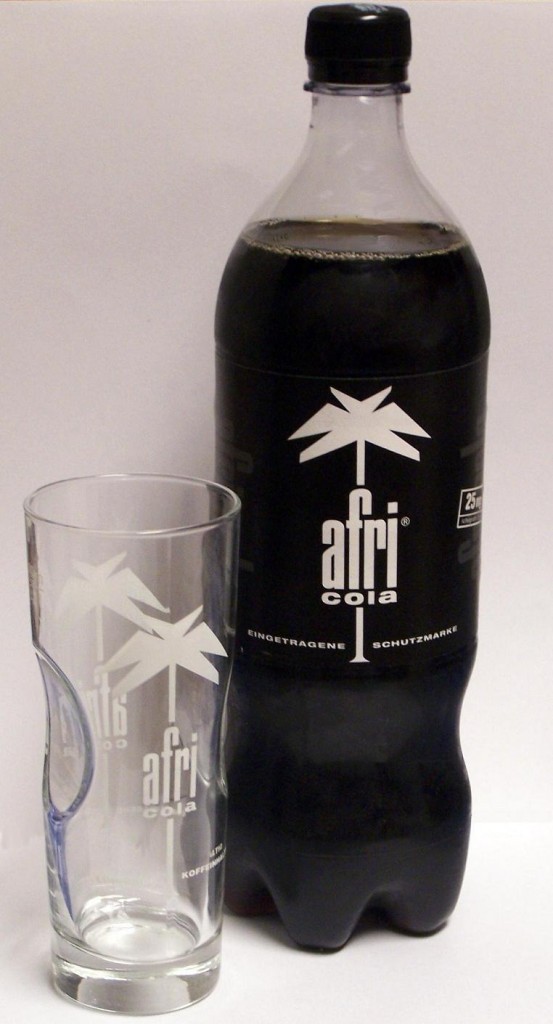 Madelaine inadvertently released a Proustian memory cascade in my mind when she played me this German soda commercial from 1968. While it looks and sounds like a perfect example of one of those distant cultural artifacts, made strange by time and nationality — which it exactly is, I suppose — it exhumed a part of my own childhood the sands of time had long obscured.
Madelaine inadvertently released a Proustian memory cascade in my mind when she played me this German soda commercial from 1968. While it looks and sounds like a perfect example of one of those distant cultural artifacts, made strange by time and nationality — which it exactly is, I suppose — it exhumed a part of my own childhood the sands of time had long obscured.
I’d just started fourth grade in a new school. Navigating its unfamiliar cafeteria on a daily basis, I grew more and more captivated by a certain bottle I’d see in the drink fridges. The stark, classy black-and-white design of its label drew me over, but its cultural associations left me bewildered. “Afri-Cola”? So, cola from Africa, right? But then, below the logo: “EINGETRAGENE SCHUTZMARKE.” German, then? Or maybe South African? Or maybe African and German? Both cultures scared me enough that I don’t think I ever actually drank the stuff, as much as my curiosity compelled me to.
No, I didn’t grow up in sixties Berlin; I grew up in nineties Seattle, where, as I’ve since found out, major drink manufacturers tended to test-market new products. When I moved to Santa Barbara and started reminiscing about the Gen-X baiting OK Soda, the blank Californian stares I got in return moved me to do some research. By virtue of growing up in that northwesterly city of marketing guinea pigs, I suppose I spend childhood in a slightly parallel product universe to the ones most American kids experience. But can someone marketing-savvy enlighten me as to why Seattle became such a preferred proving ground?
* * *
Sitting in cafés on Wilshire Boulevard, I often take a moment to watch the long, bendy, red 720 Metro Rapid buses go by. Sometimes I even ride them! If you need to travel west of Koreatown, don’t have a bike, and don’t want to pay the extra dollar to ride one of Santa Monica’s buses, they provide the present moment’s only viable option. They tend to show up less than ten minutes apart, they hold a lot of people, they only stop each mile or so, and they use some sort of technology from the future to extend their green lights (within Los Angeles city limits, that is). As the low, low standards of buses go, they have some neato aspects.
And yet, as with most branches of L.A. public transit, you have to know exactly what you’re doing to use these properly. If you accidentally overshoot your stop, you really overshoot it; often, you just have to stand around waiting for the next Rapid going the other way, which can eat up your day if you get in the habit. Despite numbers that sometimes make them look like a stream of fish migrating along Wilshire, they still take on third world-density crowds at rush hour and at night. And if you’re going to Santa Monica, prepare to spend 45 minutes, an hour, or maybe more doing so. Slick as these Rapid buses may look, buses they remain.
The word “Rapid” comes perilously close to false advertising here, evoking as it does the concept of Bus Rapid Transit (BRT) systems like Metrobús in Mexico City or RIT in Curitiba. While those systems use dedicated lanes, covered stations, and pre-boarding payment technology, L.A. Metro Rapid lines stubbornly cling to most of the qualities that make buses the least appealing form of public transportation: they share the road with cars, their stops usually amount to little more than sticks in the sidewalk, and they expect you to fumble through the standard pay-as-you-board process. (I’ve heard pleasing noises about dedicating a lane to Rapid buses during rush hour, but I can’t even imagine how that’ll work.)
But if they did run in dedicated lanes, into covered stations, carried only pre-paid passengers, etc., would they thus impede the progress of the underground Purple Line? Whenever I board a Rapid 720, it seems to scream, “This is what the subway should be doing by now!” (Or maybe I scream that; if so, I’d blend in with the unmedicated schizophrenics you often see on the buses here.) Until the Purple Line can carry us under Wilshire all the way to Santa Monica, though, you could do worse for a neither-here-nor-there stopgap solution than ride the Rapid. Unless, as I said, you’re on your bike. You’ll at least have more fun pedaling all the way there — and you might well arrive sooner.
Post a Comment